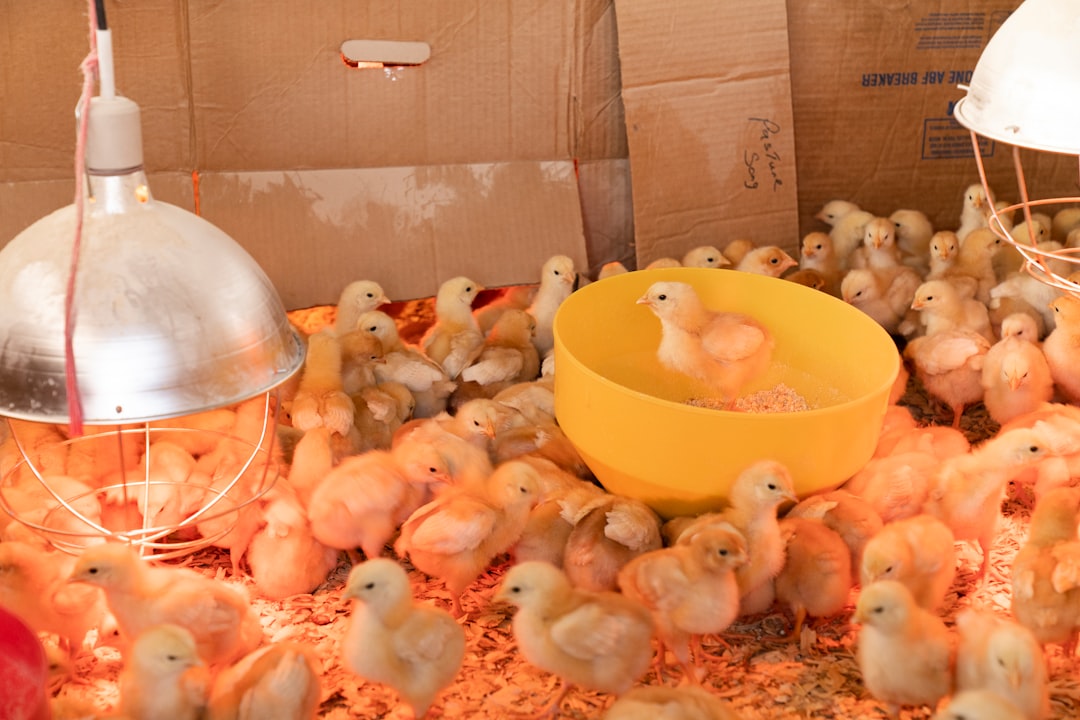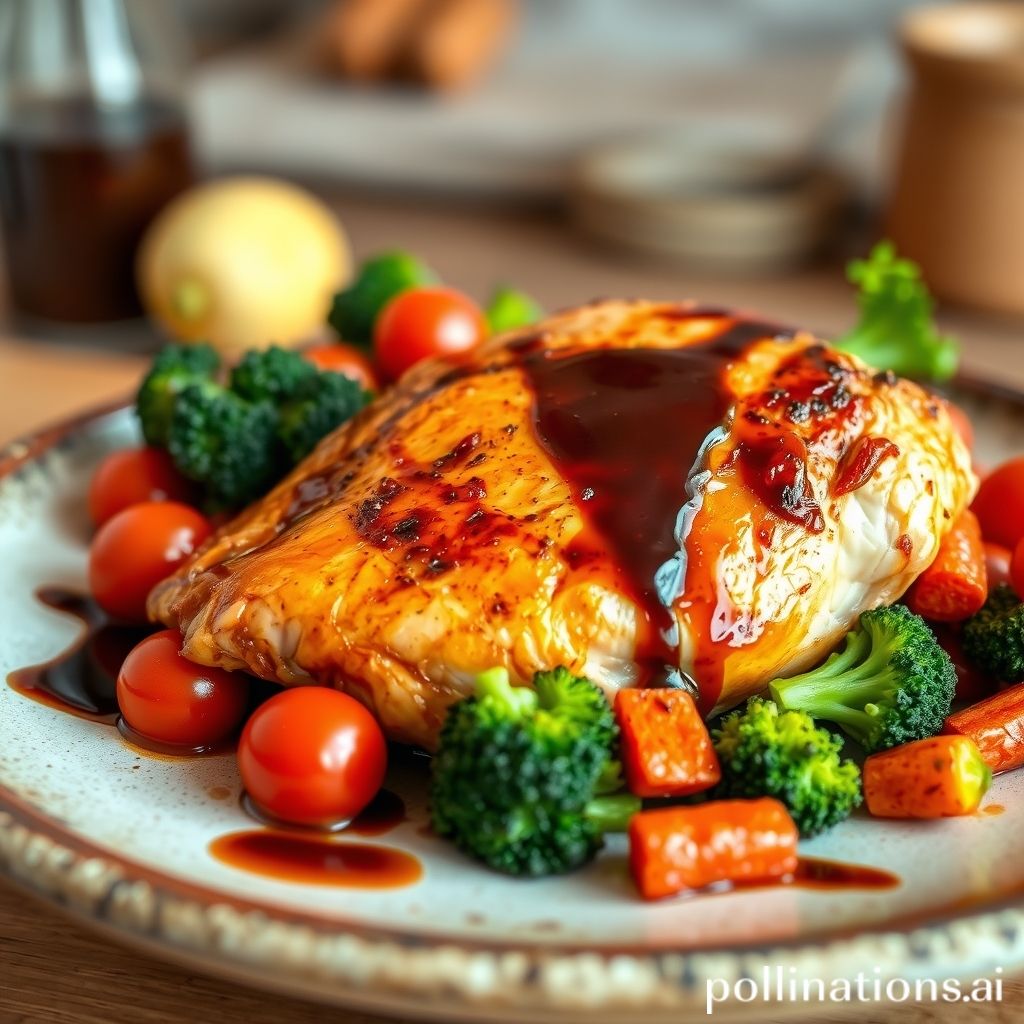Table of Contents
- Introduction
- The ingredients for the perfect balsamic glaze
- Preparation steps for balsamic glazed chicken
- Choosing and preparing the best vegetables for roasting
- Tips for cooking the chicken thighs to juicy perfection
- Pairing and serving suggestions for a complete meal
- Health benefits of incorporating this dish into your diet
- Variations and substitutions to customize the recipe
- Troubleshooting common issues and FAQs
- Conclusion
- Frequently Asked Questions
Introduction
Few culinary delights boast the elegant simplicity of Balsamic Glazed Chicken paired with Roasted Vegetables. Imagine tender chicken breasts lightly coated in a symphony of rich balsamic vinegar and sweet honey, perfectly harmonized with the subtle warmth of garlic. This dish doesn’t just satisfy hunger—it serenades the senses. Now picture this: alongside the chicken, a canvas of vibrant vegetables roasted to golden perfection—sweet peppers, tender carrots, and earthy Brussels sprouts, each bringing its own melody to this flavorful composition.
This culinary masterpiece is surprisingly straightforward yet promises a taste that elevates dinner to an art form. In today’s fast-paced world, finding a recipe that excites both novice and seasoned cooks is a treasure, and with this guide, you’ll not only master the technique but also uncover the secrets to heightening the natural flavors of each ingredient. Step into your kitchen as we explore the alchemy of transforming simple ingredients into a harmonious dish that’s sure to become a staple in your home.
The ingredients for the perfect balsamic glaze
Creating the perfect balsamic glaze involves selecting high-quality ingredients that enhance the flavor profile of your dish. The primary ingredient, balsamic vinegar, should be one of excellent quality, ideally aged, to ensure a rich and concentrated taste. Look for balsamic vinegar from Modena or Reggio Emilia, as these regions are known for producing some of the finest.
Next, incorporate a sweetener to balance the acidity of the vinegar. Brown sugar is a popular choice, adding depth and a touch of caramel flavor, but other options include honey, maple syrup, or even a bit of molasses for a bolder taste.
Garlic is another essential component, adding a subtle yet flavorful aroma. Fresh minced garlic is preferred, but you can also use garlic powder if needed.
For a hint of warmth and complexity, consider adding a pinch of red pepper flakes or a dash of black pepper. If desired, a sprig of fresh herbs like rosemary or thyme can provide a fragrant finish that ties all the flavors together.
Finally, a touch of salt amplifies the overall sweetness of the glaze, rounding out the flavors. With these ingredients, your balsamic glaze will transform any dish into a culinary masterpiece.
Preparation steps for balsamic glazed chicken
To prepare a delicious balsamic glazed chicken, start by gathering your ingredients. You will need chicken breasts, balsamic vinegar, olive oil, honey, garlic, and herbs like rosemary or thyme.
Begin by preheating your oven to 400˚F (200˚C). While the oven is heating, prepare the marinade by mixing balsamic vinegar, olive oil, honey, minced garlic, and chopped herbs in a bowl. Stir the mixture until well combined.
Next, place the chicken breasts in a shallow dish and pour half of the marinade over them, ensuring that each breast is well coated. Allow the chicken to marinate for at least 15-30 minutes for the flavors to infuse properly.
While the chicken is marinating, line a baking sheet with parchment paper. Once ready, place the chicken breasts on the sheet and drizzle with the remaining marinade. Sprinkle salt and pepper to taste.
Place the chicken in the preheated oven and bake for about 20-25 minutes, or until the chicken reaches an internal temperature of 165˚F (74˚C). During the final 5 minutes of baking, switch to broil to caramelize the glaze for added flavor.
After baking, let the chicken rest for a few minutes before serving.
Choosing and preparing the best vegetables for roasting
Choosing the right vegetables for roasting is essential to creating a flavorful and nutritious dish. Opt for a variety of colors and textures to enhance visual appeal and provide a range of nutrients. Popular choices include root vegetables like carrots, potatoes, and beets, which develop a sweet and rich flavor when roasted. Broccoli, Brussels sprouts, and bell peppers also become delightfully tender and caramelized.
When preparing vegetables for roasting, ensure they are washed, peeled if necessary, and cut into uniform sizes. This promotes even cooking and prevents some pieces from becoming overcooked while others remain underdone. Toss the vegetables in a light coating of olive oil, which helps to achieve a crisp exterior and prevents sticking. Season them with salt, pepper, and any additional herbs or spices to suit your taste profile.
Roast the vegetables on a baking sheet in a preheated oven, making sure they are spread out in a single layer to allow for proper air circulation. This method ensures they roast evenly and develop the desired caramelization. By selecting and preparing vegetables thoughtfully, you bring out their natural flavors, complementing the succulent balsamic glazed chicken perfectly.
Tips for cooking the chicken thighs to juicy perfection
Cooking chicken thighs to juicy perfection involves a few key techniques to ensure they remain tender and flavorful. First, it’s crucial to pat the chicken thighs dry with a paper towel before seasoning. This step helps the skin crisp up nicely during cooking. When seasoning, be generous with salt and pepper to enhance the natural flavors of the chicken.
Another essential tip is to use a meat thermometer to check for doneness. Chicken thighs should reach an internal temperature of 165°F (75°C) to ensure they are safe to eat while remaining juicy on the inside. It’s best to insert the thermometer into the thickest part of the thigh, away from the bone, for the most accurate reading.
Consider marinating the chicken thighs in a balsamic glaze before cooking, as this can add depth of flavor and contribute to moisture retention. Cooking methods such as baking or grilling can yield exceptional results if done correctly; ensure the oven or grill is preheated to the right temperature to avoid drying out the chicken. Finally, allow the chicken to rest for a few minutes after cooking to let the juices redistribute throughout the meat, enhancing both moisture and flavor.
Pairing and serving suggestions for a complete meal
When serving Balsamic Glazed Chicken with Roasted Vegetables, consider a selection of complementary side dishes and beverages to create a balanced and inviting meal. For a starch component, fluffy couscous or creamy mashed potatoes can provide a comforting base that absorbs the savory glaze. Quinoa or wild rice are excellent options for a healthier, whole-grain alternative. To enhance the freshness, a crisp green salad with a light vinaigrette complements the roasted vegetables beautifully.
If you’re serving this dish for a special occasion, a glass of medium-bodied red wine like Pinot Noir or a white wine such as Sauvignon Blanc can elevate the dining experience with their fruity and earthy notes. For a non-alcoholic option, consider a sparkling water spruced up with a splash of citrus or a refreshing herbal iced tea to cleanse the palate.
Finish the meal with a light dessert, such as a fruit sorbet or a berry parfait, to keep the menu fresh and satisfying. These suggestions aim to enhance the flavors of the Balsamic Glazed Chicken while ensuring the meal is varied and enjoyable for all your guests.
Health benefits of incorporating this dish into your diet
Incorporating Balsamic Glazed Chicken with Roasted Vegetables into your diet offers numerous health benefits. This dish combines lean protein and nutrient-rich vegetables, making it a balanced meal option. Chicken is an excellent source of high-quality protein, which is essential for building and repairing tissues, and maintaining muscle mass. It is also low in fat, especially when the skin is removed, making it a heart-healthy choice.
The balsamic glaze not only adds a burst of flavor but also contains antioxidants from the balsamic vinegar, which can help promote heart health by reducing bad cholesterol levels. Additionally, roasted vegetables are packed with vitamins, minerals, and fiber. Eating a variety of vegetables can improve digestive health, reduce the risk of chronic diseases, and promote overall well-being.
The combination of lean protein and vegetables helps keep you feeling full longer, which can aid in weight management. This dish is also versatile and can be customized to include a range of colorful vegetables, ensuring a diverse intake of essential nutrients. By including Balsamic Glazed Chicken with Roasted Vegetables regularly in your diet, you’re supporting a healthy lifestyle through balanced nutrition and delightful flavors.
Variations and substitutions to customize the recipe
When it comes to customizing your Balsamic Glazed Chicken with Roasted Vegetables, the possibilities are endless. One way to vary this dish is by experimenting with different types of vegetables. While the classic recipe may call for bell peppers, carrots, and zucchini, you can try adding sweet potatoes, Brussels sprouts, or cherry tomatoes for a change in texture and flavor. Additionally, swapping out the vegetables ensures that the recipe remains adaptable to seasonal produce.
If you’re looking to adjust the protein, chicken can easily be replaced with alternatives such as turkey or even firm tofu for a vegetarian version. Marinade options can also be explored; consider using honey mustard or a garlic lemon sauce for a different taste profile.
For those watching their sugar intake, consider using a sugar-free balsamic glaze or simply reducing the amount of sweetener in the glaze. Fresh herbs such as rosemary, thyme, or basil can enhance the dish’s aroma and add nuanced flavors. Spice lovers might want to sprinkle red pepper flakes or cayenne for added heat. By making these slight adjustments, you can create a dish that’s uniquely yours while still capturing the essence of balsamic-glazed perfection.
Troubleshooting common issues and FAQs
Cooking a delightful balsamic glazed chicken with roasted vegetables can sometimes present a few challenges. One common issue is the chicken drying out. To combat this, ensure you marinate the chicken well beforehand, and consider using bone-in cuts, which retain moisture better than boneless pieces.
Another frequent problem occurs when the glaze burns or becomes too sticky. This can be avoided by keeping an eye on the cooking temperature. Opt for a lower heat setting, especially toward the end of the cooking process, and add the glaze during the last few minutes of roasting to prevent it from caramelizing too quickly.
If the vegetables end up overcooked or undercooked, try cutting them into uniform pieces to ensure even cooking. Additionally, vegetables can be pre-roasted for several minutes before adding the chicken, since they often require a longer cooking time.
Lastly, balancing flavors is crucial. If the dish tastes too tart due to the balsamic vinegar, a touch of honey or brown sugar can mellow the acidity and add a pleasant sweetness. By following these tips, you can perfect your balsamic glazed chicken with roasted vegetables and create a dish that is both flavorful and visually appealing.
Conclusion
Mastering the art of Balsamic Glazed Chicken with Roasted Vegetables opens the door to creating delicious, healthy, and visually appealing meals that can impress family and guests alike. This dish combines the rich flavors of balsamic glaze with the wholesome goodness of roasted vegetables, providing a perfect balance of taste and nutrition. By following the detailed guidance on ingredients, preparation, and cooking techniques, even the most novice of cooks can achieve restaurant-quality results at home. If you’re looking for more ways to elevate your chicken recipes, The Chicken Bible is a must-have. With 500 recipes ranging from easy dinners to intricate braises and flavorful stir-fries, this book is your ultimate guide. Don’t settle for boring chicken when you can explore a world of flavors that will transform your culinary repertoire. Order your copy today and take the first step toward mastering the art of cooking chicken in endless delicious ways.

